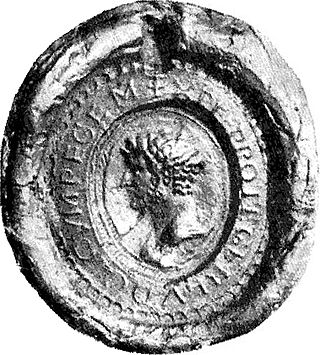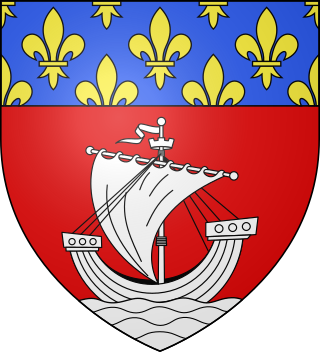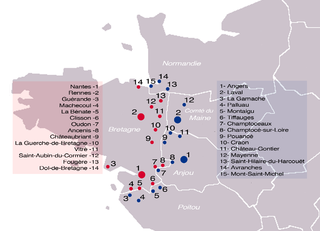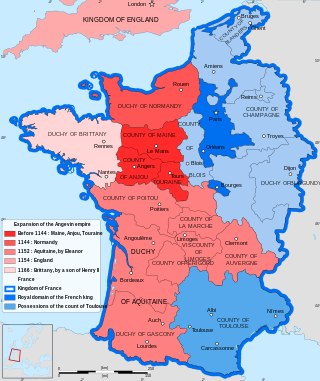Sources
- Riché, Pierre. Les Carolingiens, une famille qui fit l'Europe. 1983.
- Guillotel, Hubert. "Une autre marche de Neustrie." in Christian Settipani and Katharine S. B. Keats-Rohan, Onomastique et Parenté dans l'Occident médiéval. 2000.
Adalard, also known as Adalhard or Alard, and called the Seneschal, was a Frankish nobleman of the 9th century. He served as warden of the Norman march from 861 to 865, and was Lord Chancellor of France under Louis the Pious.
He was a son of Leuthard I of Paris and brother of Gerard II of Paris. Louis the Pious made him seneschal of the Carolingian Empire. On Louis' death, he joined Charles the Bald and arranged a marriage between the king and Ermentrude of Orléans, his niece by Ingeltrude of Fézansac and Odo, Count of Orléans. After the Treaty of Verdun (in 843), Adalard went to serve Louis the German in East Francia.
In 861, after the revolt of Carloman, Louis' eldest son, Adalard and his relatives Udo, Berengar, and Waldo took refuge at the court of Charles in Paris. Charles granted him the Norman March of Neustria, to defend it against the Vikings. However, he soon incited the jealousy of the Rorgonids, then the most powerful clan in Maine. Allied with Salomon, King of Brittany, they revolted against him and made war. After peace was settled, Charles transferred the March to Gosfrid, the representative of the Rorgonids.
He probably had a son Adalhard of Metz.

Louis I, better known as Louis the Pious, also called the Fair and the Debonaire, was King of the Franks and co-emperor with his father, Charlemagne, from 813. He was also King of Aquitaine from 781. As the only surviving son of Charlemagne and Hildegard, he became the sole ruler of the Franks after his father's death in 814, a position that he held until his death except from 833 to 834, when he was deposed.

Louis the German, also known as Louis II of Germany and Louis II of East Francia, was the first king of East Francia, and ruled from 843 to 876 AD. Grandson of emperor Charlemagne and the third son of Louis the Pious, emperor of Francia, and his first wife, Ermengarde of Hesbaye, he received the appellation Germanicus shortly after his death, when East Francia became known as the kingdom of Germany.

Charles the Bald, also known as Charles II, was a 9th-century king of West Francia (843–877), King of Italy (875–877) and emperor of the Carolingian Empire (875–877). After a series of civil wars during the reign of his father, Louis the Pious, Charles succeeded, by the Treaty of Verdun (843), in acquiring the western third of the empire. He was a grandson of Charlemagne and the youngest son of Louis the Pious by his second wife, Judith.

Count of Paris was a title for the local magnate of the district around Paris in Carolingian times. After Hugh Capet was elected King of France in 987, the title merged into the crown and fell into disuse. However, it was later revived by the Orléanist pretenders to the French throne in an attempt to evoke the legacy of Capet and his dynasty.

Pepin, born Carloman, was the son of Charlemagne and King of Italy (781–810) under the authority of his father.

Adalard of Corbie was the son of Bernard the son of Charles Martel and half-brother of Pepin; Charlemagne was his cousin. He is recognised as a saint within the Catholic and Eastern Orthodox Churches.

Judith of Bavaria was the Carolingian empress as the second wife of Louis the Pious. Marriage to Louis marked the beginning of her rise as an influential figure in the Carolingian court. She had two children with Louis, Gisela and Charles the Bald. The birth of her son led to a major dispute over the imperial succession, and tensions between her and Charles' half-brothers from Louis' first marriage. She eventually fell from grace when Charles' wife, Ermentrude of Orléans, rose to power. She was buried in 843 in Tours.

Adalard (Adalhard) of Paris was the eighth Count of Paris and a Count palatine. He was the son of Wulfhard of Flavigny and Suzanne of Paris, a daughter of Beggo, Count of Toulouse. His brother Hilduin the Young was the abbot of Saint-Denis. His brother Wulgrin I of Angoulême was appointed Count of Angoulême and Périgord. Adalard followed his uncle Leuthard II.

The Marches of Neustria were two marches created in 861 by the Carolingian king of West Francia Charles the Bald. They were ruled by officials appointed by the Monarchy of France, known as wardens, prefects or margraves. One march, was created as a buffer against the Bretons and the other against the Norsemen.
Gauzfrid of Maine was both Count of Maine and Margrave of the Norman March from 865 until his death. He was a son of Rorgon of Maine by his wife Bilechilde.
Berengar I was a 9th-century nobleman of East Francia, a son of Gebhard, Count of Lahngau, and younger brother of Udo. He and his brother were created Margraves of Neustria by Charles the Bald in 861.
Udo was a 9th-century nobleman of East Francia, a son of Gebhard, Count of Lahngau, and older brother of Berengar I of Neustria. He and his brother were afforded their position in the March of Neustria both by kinship to Adalard the Seneschal and the favour of Charles the Bald.
The Conradines or Conradiner were a dynasty of Franconian counts and dukes in the 8th to 11th Century, named after Duke Conrad the Elder and his son King Conrad I of Germany.
Wala was a son of Bernard, son of Charles Martel, and one of the principal advisers of his cousin Charlemagne, of Charlemagne's son Louis the Pious, and of Louis's son Lothair I. He succeeded his brother Adalard as abbot of Corbie and its new daughter foundation, Corvey, in 826 or 827.

The County of Anjou was a French county that was the predecessor to the Duchy of Anjou. Its capital was Angers, and its area was roughly co-extensive with the diocese of Angers. Anjou was bordered by Brittany to the west, Maine to the north, Touraine to the east and Poitou to the south. Its 12th century Count Geoffrey created the nucleus of what became the Angevin Empire. The adjectival form is Angevin, and inhabitants of Anjou are known as Angevins. In 1360, the county was raised into the Duchy of Anjou within the Kingdom of France. This duchy was later absorbed into the French royal domain in 1482 and remained a province of the kingdom until 1790.
Leuthard I of Paris was count of Paris and Fézensac.
Gerhard I of Metz was count of Metz. He was the son of Adalhard, count of Metz, himself son of Adalard the Seneschal and a daughter of Matfried, count of Eifel.
Adalhard II was Count of Metz and Mozelgau. He was probably the son of Adalard the Seneschal
The royal household of the early kings of the Franks is the subject of considerable discussion and remains controversial. This discussion is aimed at identifying the major categories of participants in the administration and those who made the major historical impacts. Every king of the Franks from Clovis I to Charles the Bald had a large cadre of advisors and bureaucrats that helped implement their regime. These supporters of the crown are frequently unknown, but often are ancestors of the later rulers of France. This is not intended to be a complete list of those supporting the kings but to serve as a guide for further study. A general discussion of the Merovingian and Carolingian dynasties can be found in the associated main articles. See also Government of the Carolingian Empire.
Jacques de Chabannes was a French nobleman and military commander during the reign of King Charles VII. The elder brother of Antoine de Chabannes, he is most notable for his significant role at the Battle of Castillon in 1453.